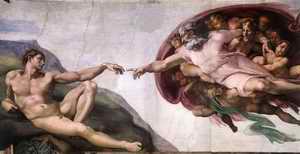 |
By the way, I've just invented blasphemy
Thought you'd like a bit of fun |
A campaigning atheist who left leaflets mocking Jesus Christ, the Pope and the Koran in the prayer room of an international airport has gone on trial charged with religious harassment.
The materials left by Harry Taylor at Liverpool's John
Lennon airport included one image showed a smiling Christ on the cross next to an advert for a brand of no nails glue. In another, Islamic suicide bombers at the gates of paradise are told: Stop, stop, we've run out of virgins.
A
further cartoon showed two Muslims holding a placard demanding equality with the caption: Not for women or gays, obviously.
Taylor, a self-styled philosophy tutor, denied bearing a grudge against people of faith and said he was only trying
to convert believers to atheism. He said: The airport is named after John Lennon and his views on religion were pretty much the same as mine. I thought that it was an insult to his memory to have a prayer room in the airport.
The
leaflets were discovered by Nicky Lees, the airport chaplain, who told the court she felt deeply offended and insulted by their contents. [But didn't mention feeling threatened].
Outlining the case against
Taylor, prosecutor Neville Biddle said that he had gone beyond freedom of expression by leaving the insulting, threatening and abusive images in a room used for worship. He said: Of course people have a right to speak freely and have a right to
insult people. It is one of the most important rights we have and it must be jealously guarded ...BUT... it is a right not without some prescription. Mr Taylor exceeded that right.
The defendant from Salford, Greater Manchester is
charged with three counts of religiously aggravated harassment, alarm or distress under the Crime and Disorder Act. The alleged offences took place on separate dates in November and December 2008.
Taylor denied the charges and said it was preposterous
to suggest that people could be incited to violence by the cartoons. He said: I am not hostile to religious people but I am hostile to religion. He told the court that he adapted cartoons cut out of newspaper and magazines like Private Eye and
added captions of his own.
The images shown to the jury included a drawing of the Pope with a condom on his finger, and a picture of a woman kneeling in front of a Catholic priest captioned with a crude pun. In another image sausages were were
labelled as The Koran .
The trial continues.
Racial and Religious Hatred Act 2006
Based on
article from opsi.gov.uk
29A
Meaning of “religious hatred”
In this Part “religious hatred” means hatred against a group of persons defined by reference to religious belief or lack of religious belief.
Acts intended to stir up religious hatred
29B Use of words or behaviour or display of written material
(1) A person who uses threatening words or behaviour, or displays any written material which is threatening, is guilty
of an offence if he intends thereby to stir up religious hatred.
29C Publishing or distributing written material
(1) A person who publishes or
distributes written material which is threatening is guilty of an offence if he intends thereby to stir up religious hatred.
29J Protection of freedom of expression
Nothing in this Part
shall be read or given effect in a way which prohibits or restricts discussion, criticism or expressions of antipathy, dislike, ridicule, insult or abuse of particular religions or the beliefs or practices of their adherents, or of any other belief
system or the beliefs or practices of its adherents, or proselytising or urging adherents of a different religion or belief system to cease practising their religion or belief system.
Update:
A Disgraceful Verdict
5th March 2010. Based on
article
from liverpooldailypost.co.uk
The jury of ten women and two men, at Liverpool Crown Court took just 15 minutes to find Harry Taylor guilt of religiously
aggravated intentional harassment, alarm or distress after viewing the grossly abusive and insulting images in court.
Harry Taylor is now on bail awaiting sentencing on 23 April. Religiously aggravated offences carry a potential
seven-year prison term.
The National Secular Society have supported Taylor. They claim that new laws dealing with religiously aggravated offences amount to a blasphemy law in another guise.
Terry Sanderson, president of the society,
said: This is a disgraceful verdict, but an inevitable one under this pernicious law. It seems incredible in the 21st Century that you might be sent to prison because someone is 'offended' by your views on their religion . . . Mr
Taylor struck me as slightly eccentric and he acted in a provocative way, challenging the necessity for the prayer room. He didn't cause any damage and he didn't harm anything, nor was he threatening or abusive. Yet he might still end up behind bars
because some Christian has decided they are offended.
In a multicultural society, none of us should have the legal right not to be offended. This law needs to be re-examined urgently.

